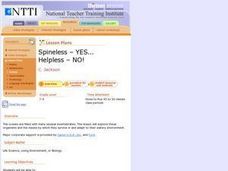Curated OER
Spineless - YES... Helpless - NO!
Students distinguish between invertebrate and vertebrate organisms while examining the zoological classes of a number of invertebrates. They illustrate a food web of these organisms and investigate the impact of humans on the oceanic...
Curated OER
Oceanography: Ocean Market
Sstudents identify consumer goods obtained from the oceans. They classify the items and calculate the cost of buying these goods. After taking a simulated sea shopping spree, they tally the cost of the items purchased. They conclude the...
Curated OER
What is an Insect?
Learners examine insects and identify physical characteristics of insects. They perform observations of insects, then use a worksheet imbedded in this plan to answer questions about them.
Curated OER
Leaf - It's What's for Dinner
Learners discover correlations in food preferences of invertebrates, and assess stream health through use of kicknets, invertebrate keys, CBL systems and probes.
Curated OER
Research Project
Young scholars learn the characteristics of arachnids by researching the arachnid of their choice and producing a 4 to 5 paragraph research paper.
Curated OER
More Bait for Your Buck!
Students determine where to buy the heaviest earthworms as they study invertebrates. They create a double bar graph of the results of the weight data.
Curated OER
Invertebrate Dribbling
Students practice proper dribbling skills and work on identifying invertebrates as one of four major types.
Curated OER
What Animal Am I?
Students brainstorm different characteristics of invertebrates and investigate invertebrates by conducting Internet research.
Curated OER
Vertebrates And Invertebrates
In this science lesson, students classify pictures into categories of vertebrates or invertebrates. After a class discussion, students divide into groups, and are given plastic baggies that contain photographs of each. The groups must...
Curated OER
Sponges - A Coloring Worksheet
In this sponges worksheet, students read the information about sponges. Students answer the provided questions about the reading passage. Students color the illustration at the bottom of the page.
Curated OER
Freshwater Invertebrates and What They Eat
In this freshwater invertebrates worksheet, students collect freshwater invertebrates and record their names, number of legs, and method of feeding. Students fill this information in on the chart. There is room to record information on...
Curated OER
Sorting Invertebrates
In this invertebrates worksheet, student sort invertebrates by their number of legs. They then identify them and record them in the boxes provided. It is unclear whether students are to collect these invertebrates or get them from a book.
Curated OER
Sorting Invertebrates with Keys
In this invertebrates worksheet, students use the 6 words in the word bank to complete the invertebrate key. They then make their own key by sorting their own invertebrates. It is unclear where students get their invertebrates, but they...
Curated OER
How Are Animals Classified?
In this animal classification worksheet, students describe the animal kingdom including invertebrates, vertebrates, birds, and mammals. This worksheet is a graphic organizer.
Curated OER
Name Scramble: Invertebrates
For this language arts and science worksheet, students analyze 10 pictures of invertebrates with scrambled names. Students decipher the names and write them correctly under each picture.
Curated OER
Who Lives In The Water
Students investigate the environment of a stream or lake to collect and observe macroinvertebrates in their natural environment. They record data and summarize the information obtained. Students look to see if there has been any human...
Curated OER
Missing Macroinvertebrates
Students investigate the concept of a macroinvertebrate. They observe the presence of increases or decreases in population in order to test for factors that contribute to the extinction of a species. Students predict the likelihood of...
Curated OER
Show Some Backbone and Teach Invertebrates
Fifth graders identify two similarities and two differences between two phyla, assign fictitious invertebrate to its phylum and explain why it belongs in that grouping, and construct member of given phylum and explain why it should be...



















